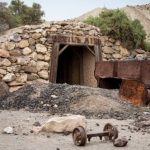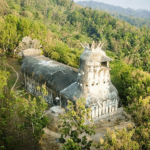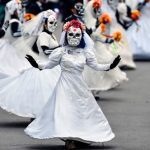 Animals
Animals  Animals
Animals  Weird Stuff
Weird Stuff 10 Weird Things People Used to Do at New Year’s
 Our World
Our World 10 Archaeological Discoveries of 2025 That Refined History
 Weird Stuff
Weird Stuff 10 Fascinating Facts You Might Not Know About Snow
 Miscellaneous
Miscellaneous Top 10 Things Crypto Was Supposed to Change & What Actually Did
 History
History 10 Huge Historical Events That Happened on Christmas Eve
 Music
Music 10 Surprising Origin Stories of Your Favorite Holiday Songs
 History
History 10 Less Than Jolly Events That Occurred on December 25
 Weird Stuff
Weird Stuff 10 Funny Ways That Researchers Overthink Christmas
 Politics
Politics 10 Political Scandals That Sent Crowds Into the Streets
 Animals
Animals 10 Species That Refused to Go Extinct
 Weird Stuff
Weird Stuff 10 Weird Things People Used to Do at New Year’s
 Our World
Our World 10 Archaeological Discoveries of 2025 That Refined History
Who's Behind Listverse?

Jamie Frater
Head Editor
Jamie founded Listverse due to an insatiable desire to share fascinating, obscure, and bizarre facts. He has been a guest speaker on numerous national radio and television stations and is a five time published author.
More About Us Weird Stuff
Weird Stuff 10 Fascinating Facts You Might Not Know About Snow
 Miscellaneous
Miscellaneous Top 10 Things Crypto Was Supposed to Change & What Actually Did
 History
History 10 Huge Historical Events That Happened on Christmas Eve
 Music
Music 10 Surprising Origin Stories of Your Favorite Holiday Songs
 History
History 10 Less Than Jolly Events That Occurred on December 25
 Weird Stuff
Weird Stuff 10 Funny Ways That Researchers Overthink Christmas
 Politics
Politics 10 Political Scandals That Sent Crowds Into the Streets
10 Odd Easter Traditions from Around the World
It is Easter again, and around the world, Christians are getting ready to commemorate the resurrection of Jesus. It is a celebration of hope and victory for those who attend sunrise services and the Easter vigil.
In addition to (or instead of) these traditional commemorations, thousands engage in other traditions. These are about as far removed from conventional Easter celebrations as you can get.
Related: 10 Holidays No One Celebrates
10 Reading Crime Novels in Norway
For many Norwegians, Easter is not about peace and celebration but about murder and mayhem (in books, at least). In Norway, reading crime novels during Easter is just as normal as hunting for bunnies and attending church services.
This “dark” tradition has its roots in an incident that happened in 1923. Norwegian authors Nordahl Grieg and Nils Lie were out of money and needed a fast, bright idea to fill their pockets. They finally decided to write a crime novel, which their publisher advertised on the Sunday before Easter. The book was titled Bergen Train Looted in the Night, and this same title was splashed across the front page of the Aftenposten newspaper.
The problem is that most people didn’t realize the title advertised a novel. They believed the train was actually robbed. The drama caused by this misunderstanding and the fact that the main characters in the book went on a ski trip during Easter is believed to be the reason behind Norway’s obsession with Easter crime.
Easter in Norway is also the beginning of spring after a long, cold winter. So Norwegians get Maundy Thursday, Good Friday, and the Monday following Easter Sunday off. Lots of time to enjoy Nordic Noir in books and on TV.[1]
9 Watching the Dance of Death in Spain
In Verges, Catalonia, Easter celebrations take on something of the traditional and then move into the macabre. Easter is commemorated in three parts, with the overall event known as the La Processó de Verges. The first part starts with Roman legionaries marching in the streets while residents look on.
The second part focuses on a theatrical performance starting at 10 p.m. The performance centers around the story of the Last Supper and Jesus’ visit to the Garden of Gethsemane. It ends with Pontius Pilate giving the order for Jesus to be crucified and washing his hands of all responsibility.
The third part of the commemoration involves a figure dressed as Jesus dragging a cross through the Verges streets for two hours. When he arrives at the Sant Julia church, the entire crucifixion, as detailed in the Bible, is acted out. That is not all, however. During the procession to the church and the crucifixion, there is a so-called Dance of the Dead.
This dance is carried out by two adults and three children dressed as skeletons. The two adults hold a scythe and a black banner that reads “Time is short” and “I spare no one.” At the same time, the children hold ash-filled plates and a clock without hands. The point of the clock is to highlight that anyone can turn into ash at any given time.
The dance takes place on Maundy Thursday, and the entire tradition is steeped in more than 300 years of history.[2]
8 Decorating an Easter Tree in Papua New Guinea
In Papua New Guinea, Easter is not about eggs and bunnies. It is also about decorating tobacco trees. Unlike the beautifully decorated Easter trees in Ireland, the tobacco trees in Papua New Guinea are adorned with tobacco sticks and packets of cigarettes.
The trees can be set up outside or inside a church and will stay there until the service is done. Afterward, the decorations are dismantled and handed out to the congregants. While puffing away, people return home for a lunch of leftovers (usually the food left over from Easter Friday).
Some even decorate tobacco trees outside of their homes, which become a place of worship during Easter.[3]
7 Throwing Water-Filled Jars from Balconies in Greece
If you should find yourself on the gorgeous island of Corfu during Easter, you may want to steer clear of pavements below balconies on Holy Saturday. On this day, locals throw large water-filled clay jugs from their balconies in full view of thousands of spectators who gather to watch. People from all over Greece come to the island to watch the chaos.
They stand close enough to where the jugs land and shatter to have the water splash on them. They most likely want some of the good luck that is said to accompany this custom. Some visitors even take shards of the broken jugs home, believing they will bring them luck.
It is believed that the Venetians, who once ruled the island, started this tradition by throwing out their old belongings making space for new ones. They did this during the New Year celebrations. When the Greeks made their own custom, they introduced the clay pots and moved their version of the tradition to Easter.[4]
6 Taking Part in a Cheese-Rolling Competition in Italy
If you don’t feel like dodging clay pots in Greece, rolling cheese in Italy may interest you this Easter. The village of Panicale celebrates Easter Monday by rolling a cheese wheel down the street. In a competition called Ruzzolone, several villages roll their cheese wheel to see who can complete the designated course in the shortest number of ‘moves’ or throws.
It is said that the competition dates back to the Roman Empire and remained popular during the Middle Ages. Today, only Panicale and a handful of other villages still partake in the tradition. The Ruzzolone competition is meant to encourage joy and celebration after a week of somber processions, masses, and reenactments of the crucifixion.[5]
5 Building a Cathedral out of Bread in Sicily
You should go to San Biagio Platani in southwest Sicily if you want some bread with your cheese wheel. During Easter every year, several residents take the time to create a display known as the Arches of Bread. This becomes a festival that sees an entire cathedral being built out of bread.
This incredible tradition was carried over from the time when Sicilians welcomed rulers from other areas by building marble and precious stone arches. Since San Biagio could not afford to create these expensive arches, they went with bread instead.
Eventually, the rulers visiting Sicily stopped demanding that arches be built in their honor. But, for San Biago, a lasting legacy was born, and they adapted their bread arches tradition for Easter. The same as with the cheese wheels, the bread arches have become something of a competition.
Today, locals are grouped into two teams that work to recreate the San Biago church’s interior. One team works on the altar dedicated to Jesus, and the other works on the altar for Mary. Both teams work hard for weeks to unveil their masterpieces on Easter Sunday.[6]
4 Dining in Georgian Cemeteries
For most people, Easter is a time they want to spend with their families. For some, it also means spending time with family members who are no longer with them. During Orthodox Easter in Georgia, cemeteries quickly fill up with families carrying red rolling eggs, platters of food, and wine. They enjoy the food and wine while remembering and talking to their deceased loved ones.
This ritual typically happens on Easter Monday or the day after, even though the official day set by the Orthodox Church is the Tuesday after Easter. Some of the families leave food behind, including meat and sweets. They also place newly sprouted wheat on their loved one’s graves. Unfortunately, some drink too much and disturb other families inside the cemeteries.
Getting drunk in a cemetery wasn’t part of the original tradition that is believed to have started as far back as 1921. This trend has started a debate on whether feasting inside a cemetery should be allowed to continue in the future.[7]
3 Setting the Hills on Fire in Texas
Fredericksburg is known as Texas’s most famous German town. Part of this fame comes from the town’s strange tradition of lighting hills on fire during Easter. It all starts the night before Easter when some locals dress up as Easter bunnies, pioneers, and Comanches. Others ascend the more than 20 hills surrounding the town and wait for all the lights to shut off and the church bells to start ringing.
When this happens, they set fire to the ready and waiting stacks of brush and wood. As the lights go down and bells ring out, the flames lick their way across the hills. The fires are set to honor a peace treaty that the Fredericksburg founders signed with the Comanches in 1847. This is according to local legend.
Around Easter, the townsmen went over the hills to negotiate with the Comanches. At the same time, the Comanches took up positions on the hilltops, sending smoke signals. The women and children left behind did not know what the smoke meant, so they started to panic. Fortunately, one woman kept calm and told a simple story about the Easter bunny lighting the fires to boil his Easter eggs.
Everyone calmed down enough to wait for the men to return, which they did after a short while.[8]
2 Easter Egg Showers in Mexico
Mexico follows a much lighter and smoke-free tradition for Easter, namely filling hollowed-out eggs with confetti. These colorful eggs are called cascarones; families break them over a designated person’s head. When the confetti rains over them, they also receive a share of good luck.
The person receiving the luck doesn’t always know about it until an egg is cracked over their head, though. Most families visit a park to celebrate Easter Sunday, where the kids hide their confetti eggs. When the unsuspected designated person turns up, they run to them to break an egg over their head.
This tradition has evolved since the Spaniards first introduced it. This funny egg custom is also associated with the Italian Renaissance. During that time, men would fill eggs with perfumed powder and toss them at the women they loved.[9]
1 Burying Fish in Ireland
Of all the traditions on this list, the Irish mock herring funeral is the only one no longer followed. A long time ago, the Irish would avoid eating meat during the forty days of Lent. Butchers did not have a fun time since they could only sell herring.
However, when the forty days were over, those abstaining from meat were just as tired of the tradition as the butchers. They were so tired of it, in fact, that they went through all the trouble of celebrating the end of Lent with a funeral for herring.
The relieved butchers would typically arrange the funeral ceremony, which consisted of attaching a fish to a piece of wood and carrying it in a procession. People would whip the fish until the procession reached a bridge, and it was tossed into the river. The end of the procession also meant a feast of lamb and loud music as people hurled insults at the poor fish.[10]








